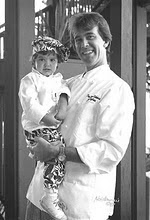The History of Christmas Cookies
 |
| My Daughter Maggie |
Historians note that the first cookies were made over 10,000 years ago by Neolithic farmers. They made a concoction of grains mixed with hot water into a paste and baked them on hot rocks. Light weight, durable, easy to transport and with a good shelf life, they were ideal for the nomads. Fortunately, we’ve come a long way!
In this article we will look at the history of Christmas cookies, varying traditions by nation and I will share a couple of recipes from one of my favorite cooks, my Mom.
The tradition of Christmas cookie dates back to the 16th century in medieval Europe. German families baked pans of Lebkuchen or Gingerbread.
In Sweden, Papparkaker (spicy ginger and black pepper crackers) is the favorite.
Krumkake (lemon and cardamom scented wafers) is the choice of the Norwegians. However, this may be a bit of a challenge in Norway this year. Unfortunately, they are suffering from a severe butter shortage. It appears that someone miscalculate the country’s milk supply. Even though, there’s plenty of Jarlsburg cheese, a traditional and famous Norwegian Swiss style cheese, both (Jarlsburg and butter) are useful items but hardly interchangeable.
In Sweden, Papparkaker (spicy ginger and black pepper crackers) is the favorite.
Krumkake (lemon and cardamom scented wafers) is the choice of the Norwegians. However, this may be a bit of a challenge in Norway this year. Unfortunately, they are suffering from a severe butter shortage. It appears that someone miscalculate the country’s milk supply. Even though, there’s plenty of Jarlsburg cheese, a traditional and famous Norwegian Swiss style cheese, both (Jarlsburg and butter) are useful items but hardly interchangeable.
The earliest examples of Christmas cookies in the United States were brought by the Dutch in the early 17th century. From 1871 to 1906, trade and import was cheap. That being said, the cookie cutter was introduced in the States from Germany. Christmas cookies at that point took on a new life. As a matter of fact, in 1907 Nabisco got into the act. Did you know that Animal Crackers originated as a Christmas tree ornament (that’s what the string on the box is for)? They use 8,000 mile of string each year for their retro boxes.
In the U.S., children have been leaving Christmas cookies and milk for Santa each Christmas eve since the 1930’s. That’s roughly 84,000,000 cookies he’s enjoying that night. Let’s take a look at the cookies and traditions from other nations.
 |
| Christmas Cookies |
· Germany – Gingerbread (Lubkuchen)
This confection dates back to 1395 in Nuremberg. The recipe was originally developed during the early days of the spice trade when sugar was expensive and a luxury. Honey was the sweetener most commonly used. Until 1867, Lubkuchen were made entirely by hand.
· Sweden – Gingersnaps (Pepparkaror)
There is no cookie that says “Christmas in Sweden” more than the traditional Pepparkaror. Place the cookie in the palm of your hand. Make a wish and tap on the middle of the cookie. If it breaks into three pieces, your wish will come true!
· Norway – Fattigmann
Also known as the poor man’s cookie, this deep fried dough is still enjoyed in parts of northern North America where Scandinavians settled.
· Norway – Krumkake
Centuries ago, Krumkake was baked over open flames in decorative cast irons, creating beautiful thin wafers. They are named after the crumbs left in your hand after taking the first bite.
· United States – The Sugar Cookie
Heralding from the Nazareth region of Pennsylvania in the mid 18th century, the sugar cookie was originally shaped like a keystone to represent the states symbol. In was introduced into legislation on September 5, 2001 as the states official cookie.
And now for some favorite holiday recipes from my Mom. I hope you enjoy the cookies (I always do!) but most importantly, I hope you have an enjoyable holiday with family and friends.
Raspberry Lemon Thumbprint Cookies
1/2 Cup Raspberry Jam or Jelly
1 Tablespoon Chambord or Kirsch
2 1/4 Cups All-purpose flour
1 Teaspoon Baking powder
1/4 Teaspoon Salt
2 Sticks Butter at room temperature
2/3 Cup Sugar
2 Tablespoon Large Egg Yolks
1 Tablespoon Finely Grated Lemon Zest
1 Tablespoon Fresh Lemon Juice
1 Teaspoon Vanilla Extract
Preheat oven to 350 degrees. Lightly butter 2 large baking sheets.
In a small bowl combine the jam and chambord. Stir to combine.
In a medium bowl combine flour, baking powder and salt and wisk to blend.
In a large bowl using an electric mixer, beat butter and sugar until light.
Add egg yolks one at a time and beat.
Add flour mixture and mix well.
Add egg yolks one at a time and beat.
Add flour mixture and mix well.
Add lemon zest, juice and vanilla and mix.
Roll dough into small balls. Make an indentation in top with your thumb. Spoon small amount of raspberry mixture into the indentation.
Bake until until lightly brown or about 10 minutes.
Macadamia, Cherry & White Chocolate Cookies
12 Ounces All-purpose flour
2 Teaspoons Baking powder
1/4 Teaspoons Mace – ground
4 Ounces Unsalted butter – softened
8 Ounces Granulated sugar
1 Teaspoons Vanilla extract
1 Egg
1 Cup Dried Cherries
1 Cup Macadamia nuts
4 Ounces White chocolate chunks
1 Tablespoon Orange zest
Stir together the flour, baking powder and mace. Set aside.
Cream the butter and sugar until light and fluffy.
Blend in the vanilla extract. Add the egg and beat again until fluffy.
Gradually add the flour mixture, beating just until well combined.
Add cherries, nuts, chocolate and orange zest.
Drop on cookie sheet in small mounds.
Bake at 350°F until golden brown, approximately 12 to 14 minutes. Let stand for 1 minute, then transfer to wire racks to cool.








